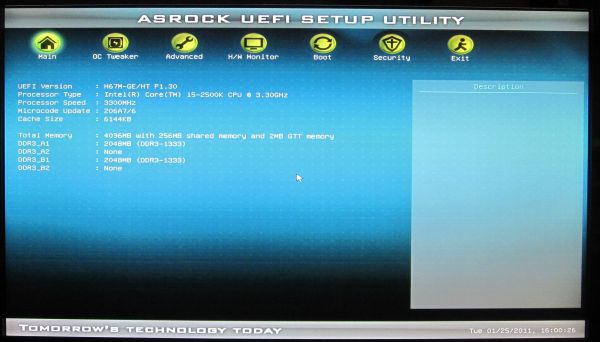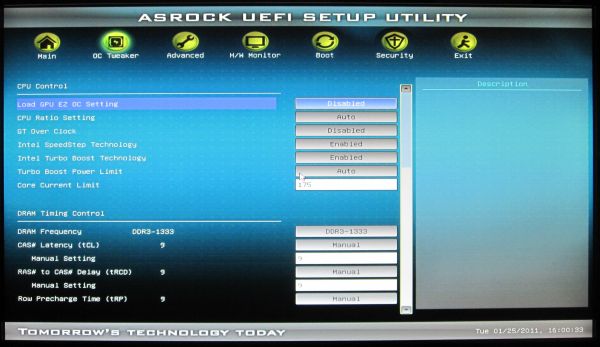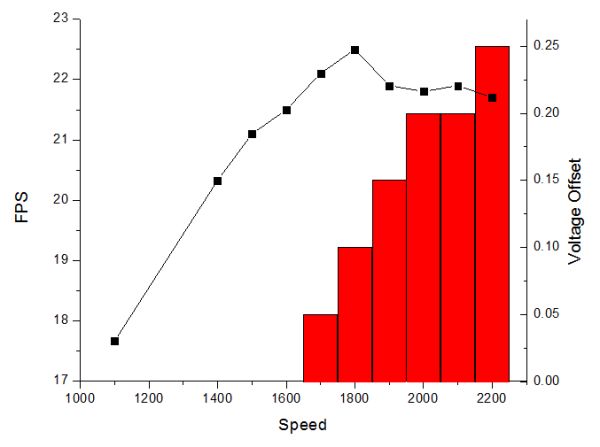H67 – A Triumvirate of Tantalizing Technology
by Ian Cutress on March 27, 2011 6:25 PM EST- Posted in
- Motherboards
- Sandy Bridge
- H67
UEFI
The ASRock UEFI we have with the H67M-GE/HT is almost identical to the P67 UEFI – a series of BIOS options on a graphical interface with use of a mouse. Alongside the booting speed benefits of the UEFI, it is pleasing to see that the graphical interface is going to become the future. The ASRock UEFI is an 8MB file, double the size of the ASUS and Gigabyte equivalents (excluding GB’s dual boot BIOS system), so there is plenty of room to grow.
As before, you will find that in the UEFI, the mouse wheel does not work. This is not a massive deal-breaker, by any means. I still prefer using the keyboard to navigate all the options, and I had no issues in using the arrow keys. You cannot use the number pad to put in voltages and such, which would be a nice touch.
The main difference between the P67 and the H67 versions of the ASRock UEFI is the overclock options which allow the GPU overclocking. The GPU EZ Settings give options between 1400 and 1600 MHz options with my 2500K, all of which work off the bat (see the overclock section below). The memory OC options are also fairly similar to the P67, except here you will only get a choice of Auto, DDR3-1000 or DDR3-1333 MHz options. All the timings are adjustable too.
Overclocking
Overclocking for the H67 series of motherboards is limited to the integrated GPU only. On our 2500K ES processor, we have Intel’s latest HD3000 integrated graphics solution, containing 12 EUs (similar to NVIDIA CUDA cores or AMD SPs) which run at 850 MHz standard and 1100 MHz turbo.
The UEFI or BIOS implementation essentially determines how you overclock the integrated graphics solution. In this instance, while the ASRock AXTU software allows changing the graphics speed, a restart is required each time it is used. Inside the UEFI itself, you have two overclocking options.
Firstly, is the predefined easy overclock option. On ASRock boards of late, I have been enjoying this option, as more often than not, just one click and it works. The ASRock H67M-GE/HT gave three options with my 2500K – 1400, 1500 and 1600 MHz. Each of these modes worked flawlessly first time, no problems. On Metro 2033 1024x768 on Normal graphics, an increase from 17.67 fps at default to 21.50 fps was seen at 1600 MHz.
The other option to overclock via the UEFI is manually increasing the speed in 50 MHz jumps, up to a 3000 MHz option. Also combined with this is an IGP voltage offset setting, allowing +0.05 V to +0.25 V in 0.05 V jumps. Below are the results from slowly increasing the MHz and increasing the voltage as required when the benchmark became unstable:
What was interesting to me was that I was able to boot easily, and the only failures came during heavy GPU usage. At 1900 MHz, the fps decreased, to which I was initially confused about. I upped the voltage further (to +0.25V) but to no avail, still got 21.90 fps. Even upping the power limits to 150 W, and the core current limit to 200 A, no change is observed. This leads me to the conclusion that at a certain point, the GPU will clock back to a safe(r) value (even if GPU MHz monitoring tools keep reporting the UEFI selected value), no matter what voltage setting is chosen, and there may be a peak in terms of performance which is fine tunable. This will be confirmed by testing other boards.
The best OC gave:
- Metro2033: 22.5 FPS, up 27.3% from 17.67 FPS
- Dirt2: 29.6 FPS, up 10.0% from 26.93 FPS



















56 Comments
View All Comments
MrSpadge - Wednesday, March 30, 2011 - link
Well done, Gigabyte! And it's a shame how poorly the others are doing in comparison. I fI wanted high power consumption I could just stick with an old machine or get an AMD..Not wanting to start a bashing / flame war. It's just that in my eyes the exceptional power consumption (especially idle) of the Sandy Bridge + IGP (plus excellent performance) is what makes it really attractive for really many roles.
MrS
trogthefirst - Thursday, March 31, 2011 - link
Actually i was torn between H67/61 and one of those 785G/880G platforms for my aunt recently - non gaming build In the end she needed multi display scalable to possibly 3-4 displays so i went with a cheapo 880G and an $70ish AthlonII X3 With the Surround View feature you could run, with a Radeon GPU up to 4 displays (2 from integrated graphics) and 2 off something like a passively cooled HD 4350/5450 Sounds like a lot of expansion, features, etc for such a cheap platform if u ask me!loimlo - Thursday, March 31, 2011 - link
Dear IanWould you like to share us with Power cumsumption measurement detail?
1. Is it DC or AC draws?
2. How do you measure the watts? From the wall plug by using Kill-a-watt?
3. Did you give not so useful MB's energy-efficiency software like ASRock IES, Gigabyte Energy Saver?
That said, I never had good experience with these softwares, especially Gigabyte one.
ShadowVlican - Thursday, April 7, 2011 - link
did you guys measure total system power consumption, or is that just motherboard? looking to build a HTPC, would love something modern and doesn't eat powertpk911 - Wednesday, April 20, 2011 - link
Intel to release Z68 chipsets in first half of MayMonica Chen, Taipei; Steve Shen, DIGITIMES [Wednesday 20 April 2011]
http://www.digitimes.com/news/a20110419PD212.html
Intel will release its Z68 chipsets in the first half of May, with Gigabyte Technology likely to be the first major motherboard maker to launch Z68-based products as soon as its embargo expires. Gigabyte's offerings will include its top-end GA-Z68X-UD7-B3 model.
Motherboard makers have also reportedly been informed that Intel will focus more on its Z- and H-series chipsets.
The share of P67-series motherboards will begin dropping once the Z68 is launched and the segment will gradually be phased out, with the P-series not being included in Intel's next generation chipsets.
...just a quick update, if I may :)
gsuburban - Sunday, February 12, 2012 - link
I wanted to upgrade from an Asus P5 series board and found most of the P8 boards had no floppy or ide (pata) interface on them. Since I still have 2 great BenQ 1655 DVD recorders, they wouldn't be usable without buying a PCI PATA card. After looking matters over I didn't see much benefit in using up 2 of 6 SATA ports since I have at least 4 hard drives and would be limited on SATA ports etc.I thought it over and discovered the P8H67-V and P8H67-M Pro by Asus still had the ide interface on board. No floppy but at least the IDE was there which would yield 6 SATA ports available without using them for the DVD-Optical.
I use XP Pro still since it does have it's advantages in some areas and not having the floppy drive is the pits as you can't load AHCI drivers via the F6 prompt in setup. I tried all sorts of ideas such as a custom image that included the AHCI drivers etc without success.
The P67 boards are totally fine and they run fast with the right CPU and memory but they are best used with Windows 7. The H67 boards save you about $250 since you don't need a video card, the boards are less than the P67's and with the select models, you get an IDE port which also frees up 2 SATA ports for those who still have IDE devices.
H67 would be my choice for high performance every day computing since the graphics are much improved from the days of G series and price is low, around $105.
I think it's too soon to eliminate the floppy and IDE interface at any rate.